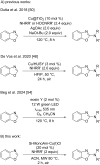Microwave-enhanced additive-free C-H amination of benzoxazoles catalysed by supported copper
- PMID: 40692986
- PMCID: PMC12278112
- DOI: 10.3762/bjoc.21.108
Microwave-enhanced additive-free C-H amination of benzoxazoles catalysed by supported copper
Abstract
The C2-amination of benzoxazole offers wide-ranging potential for substrate expansion and the functionalisation of bioactive compounds. This study presents a green and efficient C-H amination, catalysed by CuCl and CuCl2, in acetonitrile without acidic, basic or oxidant additives that is accelerated by microwave (MW) irradiation and is completed in 1.5-2 h. A solid Cu(I) catalyst supported on aminated silica made the process cost-effective and heterogeneous, thus simplifying work-up and minimising free copper in solution. The catalyst was found to be regeneratable and reusable for up to eight cycles. The optimised method facilitated the synthesis of various benzoxazole derivatives, demonstrating its versatility and practical applicability.
Keywords: aerobic oxidation; copper; grafted silica; heterogeneous catalysis; microwave.
Copyright © 2025, Paraschiv et al.
Figures












Similar articles
-
Home treatment for mental health problems: a systematic review.Health Technol Assess. 2001;5(15):1-139. doi: 10.3310/hta5150. Health Technol Assess. 2001. PMID: 11532236
-
123I-MIBG scintigraphy and 18F-FDG-PET imaging for diagnosing neuroblastoma.Cochrane Database Syst Rev. 2015 Sep 29;2015(9):CD009263. doi: 10.1002/14651858.CD009263.pub2. Cochrane Database Syst Rev. 2015. PMID: 26417712 Free PMC article.
-
Gonadotropin-releasing hormone (GnRH) analogues for premenstrual syndrome (PMS).Cochrane Database Syst Rev. 2025 Jun 10;6(6):CD011330. doi: 10.1002/14651858.CD011330.pub2. Cochrane Database Syst Rev. 2025. PMID: 40492482 Review.
-
NIH Consensus Statement on Management of Hepatitis C: 2002.NIH Consens State Sci Statements. 2002 Jun 10-12;19(3):1-46. NIH Consens State Sci Statements. 2002. PMID: 14768714
-
A rapid and systematic review of the clinical effectiveness and cost-effectiveness of paclitaxel, docetaxel, gemcitabine and vinorelbine in non-small-cell lung cancer.Health Technol Assess. 2001;5(32):1-195. doi: 10.3310/hta5320. Health Technol Assess. 2001. PMID: 12065068
References
-
- Abdullahi A, Yeong K Y. Med Chem Res. 2024;33:406–438. doi: 10.1007/s00044-024-03190-7. - DOI
LinkOut - more resources
Full Text Sources
Miscellaneous
